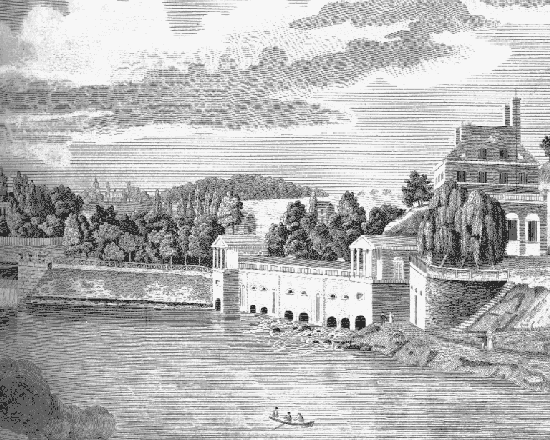The Fairmount Waterworks
Today, we give up high-tech for something simpler. The University of Houston's College of Engineering presents this series about the machines that make our civilization run, and the people whose ingenuity created them.
Eighteen-year-old Mark Twain visited Philadelphia's Fairmount Waterworks in 1853. He wrote his brother Orion about its lovely park, its marble cupids and fountains, and the reservoir on the hill. By then this remarkable engineering feat was forty years old. It was the first large-scale big-city water-supply system.
Philadelphia began claiming leadership in water supply soon after the American Revolution. In 1800 Benjamin Latrobe built a set of steam-powered pumps. It was right downtown, but it kept failing. So he launched a vast improvement -- a larger system on the Schuylkill River, just outside town. It was powered by two, much better, engines.
The new system began delivering water in 1815. Its main power-supply was a Watt engine -- huge and impressive, but already dated. The other engine was more compact. It was made by the American Oliver Evans. The Watt engine was out of service more often than not. Evans's smaller engine did the lion's share of pumping.
It took 3600 cords of wood each year to generate steam -- more than the city could afford. In 1822 Philadelphia finally put away what'd been the cutting edge of power technology. They replaced the engines with a set of eight water wheels.
Charles Dickens visited the Works in 1840 and said,
Philadelphia is most bountifully provided with fresh water. [It] is powered and jerked about, and turned on, and poured off everywhere. The Waterworks ... are no less ornamental than useful ... The river is dammed ... and forced by its own power into ... reservoirs, whence the whole city ... is supplied at a ... trifling expense.
Water wheels were medieval machines. Yet Philadelphia had built a great celebration of modern technology upon them. Not until Mark Twain's visit had the first water turbine been added to the system.
The Waterworks kept serving Philadelphia until the Schuylkill river became polluted, around 1900. Today, its lovely old buildings still line the river. The City Art Museum now looms on the hilltop were the reservoir once was.
It's a beautiful site -- lightly wooded and grassy -- with the old neoclassical buildings and sculpture. The dam is still there in the river. But hidden behind this early American expression of high technology lurks a message we should all remember. It is that we must not be dazzled by the latest and the hottest, when low-tech simplicity can serve us better.
I'm John Lienhard, at the University of Houston, where we're interested in the way inventive minds work.
(Theme music)
Gibson, J.M., The Fairmount Waterworks, Bulletin of the Philadelphia Museum of Art, Vol. 84, Nos. 360 & 361, Summer 1988.
For Thomas Doughty's painting, View of the Fairmont Water Works from the Opposite Side of the Schuylkill River: c1825 (Museum of Fine Arts, Houston.) Click Here.

(From the 1832 Edinburgh Encyclopaedia)
The Fairmount Waterworks